Chitwan National Park: The Real Deal Safari Experience
Let's cut through the canned safari brochures and Instagram filters—Chitwan National Park is where Nepal's wildlife gets down to business. This isn't some staged nature show; it's 952 square kilometers of untamed jungle where rhinos charge through elephant grass, tigers ghost through sal forests, and crocodiles lurk just beneath the surface of the Rapti River. What makes Chitwan special? It's wild enough to get your pulse racing but accessible enough that you don't need Bear Grylls' survival skills to enjoy it.
I've spent weeks in these jungles, and here's the unfiltered truth about what makes Chitwan worth your time—the good, the bad, and the downright chaotic.
The Chitwan Vibe: Where Civilization Meets Pure Jungle Madness
Chitwan hits different from other safari destinations. One minute you're sipping surprisingly good espresso at a German bakery in Sauraha (yes, really), the next you're standing knee-deep in swamp grass while your guide whispers "rhino at 2 o'clock." The park's magic lies in these contrasts—it's raw enough to feel adventurous but developed enough that you're not roughing it completely.
The terrain? A mix of riverine forests so dense the sunlight barely penetrates, open grasslands where rhinos graze like living tanks, and oxbow lakes that mirror the sky. Unlike Nepal's mountain treks, altitude isn't an issue here—you're at a steamy 150 meters above sea level. The real challenge? The humidity that clings to you like a second skin and the mosquitoes that treat bug spray like a mild suggestion.
Jeep safaris here aren't the sterile, zoo-like experiences you might fear. The vehicles rumble down dirt tracks, their engines scaring off everything except the boldest rhinos. Canoe rides down the Rapti River feel straight out of Jurassic Park, with crocodiles eyeballing your every paddle stroke. And then there's the elephant-back safaris—controversial, yes, but still a Chitwan staple that lets you get dangerously close to wallowing rhinos.
But the real thrill? The jungle walks. Armed with nothing but a stick (and hopefully a competent guide), you'll creep through sal forests where every rustle could be a deer... or something far less friendly. It's in these moments—when the jungle goes quiet and your guide freezes—that Chitwan reveals its true wild heart.
Chitwan's Wildlife: Nature's Most Dramatic Soap Opera
This isn't some sanitized nature documentary—Chitwan's animals don't follow scripts or show up on cue. Here's who you might meet:
The One-Horned Rhinos
Chitwan's undisputed rock stars. These 2,000kg tanks love to photobomb jeep safaris, especially in the Bis Hajaar Tal wetlands where they wallow like overgrown puppies. Seeing one charge through the grass—yes, they can hit 30km/h—will reset your definition of "wild."
Bengal Tigers
The park's most elusive celebrities. Unlike India's tiger reserves, Chitwan doesn't guarantee sightings. Your best bet? Dawn near Sauraha's buffer zones when deer alarm calls give away a tiger's position. Even if you don't see one, knowing they're watching you adds serious spice to every jungle walk.
Sloth Bears
Forget Baloo—these guys are more "rip your face off" than "bare necessities." Rare but unforgettable if spotted, usually when they're tearing apart termite mounds.
Gharial Crocodiles
Living fossils with snouts like tweezers, sunbathing en masse on Rapti River sandbanks. The canoe ride past them is equal parts mesmerizing and terrifying.
Leopards
The park's ninjas—seen only by the luckiest (or most patient) visitors. They prefer the dense sal forests where dappled light makes them nearly invisible.
Birdlife
From electric-blue kingfishers to prehistoric-looking hornbills, Chitwan hosts over 550 species. The oxbow lakes turn into bird parties at dawn.
(And then there are the elephants—both wild ones trumpeting in the distance and the park's "domesticated" herd (ethical questions aside))
Navigating Chitwan: From Tourist Hub to Wild Heart
Your Chitwan adventure starts in Sauraha, the park's gateway town that somehow manages to be both charming and slightly chaotic. Think backpacker hostels, overpriced "jungle resorts," and those random German bakeries serving surprisingly good apple strudel (a legacy of Nepal's hippie trail days).
From Sauraha, the real wild begins:
Rapti River Canoe Ride
This silent morning drift past basking crocodiles is where reality hits—those gharials aren't animatronics. The tension is real as your dugout canoe floats inches from their toothy grins, while your guide remains annoyingly casual.
Bis Hajaar Tal
Translation: "Twenty Thousand Lakes." This rhino magnet lives up to its name in monsoon, shrinking to swampy grasslands in dry season. It's where you'll see rhinos belly-deep in water, looking like grumpy old men in a bath.
Sal Forests
Towering trees where leopards stalk and langur monkeys scream warnings. Jeep trails wind through here, but the best sightings happen on foot (with armed guides, obviously).
Elephant Breeding Center
The ethical debate rages, but this remains a Chitwan staple. The baby elephants are adorable; the politics surrounding them... complicated.
Tharu Villages
Indigenous communities living on the park's edge. Their cultural shows walk a fine line between authentic tradition and tourist spectacle.
(Unlike Bardiya's remoteness, Chitwan's routes are well-trodden but still wild at heart—if you know where to look.)
Chitwan National Park Safari Highlights: Where Wild Adventures and Unforgettable Encounters Collide
Forget cookie-cutter wildlife tours—Chitwan serves up raw, unfiltered jungle experiences that stick with you long after the bug bites fade. This is where your camera gets its workout, your adrenaline spikes, and your definition of "wild" gets rewritten. Here are the can't-miss moments that make Chitwan Nepal's most thrilling (and occasionally absurd) safari destination:
Unmissable Chitwan Safari Highlights
- Golden Hour Jeep Safari Through the Grasslands
Cruise through golden elephant grass as rhinos emerge like prehistoric ghosts at dusk. Prime photography time in Bis Hajaar Tal wetlands. - Heart-Pounding Canoe Ride Along the Rapti River
Glide silently past dozens of gharial crocodiles sunbathing on sandbanks—their toothy grins just inches from your paddle. - Dawn Jungle Walk with Armed Guides
Track tigers on foot through sal forests where langur monkey alarm calls reveal predator movements. Every rustle spikes your pulse. - Rhino Encounters at Bis Hajaar Tal
Watch 2,000kg one-horned rhinos wallow in swampy ponds like grumpy old men in a bathhouse. - Elephant Bathing Sessions (Ethical Dilemmas Included)
Witness rescued elephants spray water like firehoses while mahouts scrub them down—equal parts magical and morally complex. - Tharu Cultural Night with Stick Dances
Indigenous fire dances and tribal performances that walk the line between authentic tradition and tourist spectacle. - Birdwatching at Oxbow Lakes
Spot rare giant hornbills, iridescent kingfishers, and fishing eagles at Devi Tal and other seasonal lakes. - Sunrise Over the Rapti River
Misty morning views of crocodile silhouettes and mirrored waters—nature's best light show. - Safari Lodge Campfire Story Swaps
Exchange "almost saw a tiger" tales with fellow travelers over Everest beers in Sauraha's riverside bars. - Sloth Bear Spotting in Termite Mound Zones
Catch these rare, shaggy beasts tearing apart termite mounds—way more aggressive than their Jungle Book reputation. - Village Cycling Tours to Tharu Communities
Bike through local villages where homes feature vibrant animal murals and rice fields glow at sunset. - The Elusive Tiger Chase
Spend evenings listening for alarm calls near Sauraha buffer zones—where seeing stripes is rare but hearing them chuff is electrifying.
(Pro Tip: Pack binoculars, extra camera batteries, and a healthy tolerance for "planned spontaneity"—wildlife runs on jungle time, not tourist schedules.)
When to Visit Chitwan National Park: The Ultimate Seasonal Guide
Let’s be real—timing your Chitwan safari wrong means sweating through your shirt while leeches party on your ankles, or worse, staring at empty grasslands because the animals are hiding from monsoons. Here’s the no-BS breakdown of Chitwan’s seasons, ranked from "perfect" to "why would you do this to yourself?"
1. Prime Time: October – March (Dry Season Bliss)
Why It’s Gold:
- Wildlife Galore: Water sources shrink, forcing rhinos, tigers, and deer to congregate at rivers and lakes. Your chances of spotting them? Sky-high.
- Weather You Can Actually Enjoy: Days hover around 25°C (77°F), nights dip to 10°C (50°F). No suffocating heat, no monsoon sludge.
- Crystal-Clear Visibility: Dust-free air + golden light = those NatGeo-worthy safari shots.
- Trails Are Actually Walkable: No knee-deep mud, just packed earth perfect for jungle walks.
Best For:
- First-time visitors
- Photographers
- People who hate sweating through their clothes
Downsides:
- Peak Tourist Season: Book lodges and safaris weeks ahead.
- Morning Fog: Can delay canoe rides until the sun burns it off.
2. Shoulder Season: April – June (The Sweat Fest)
Why Go?
- Tigers at Dawn: As temperatures soar, predators drink early. Your best shot at stripes.
- Budget Deals: Lodges drop prices by 30-50%.
- Empty Trails: Most tourists flee the heat—you’ll have jeep safaris almost to yourself.
The Catch?
- Blistering Heat: 40°C (104°F) by midday. Hydrate or collapse.
- Grass Is Taller: Makes spotting wildlife trickier (except at waterholes).
- Dust Storms: April kicks up swirling dirt clouds—not great for photos.
Best For:
- Hardcore wildlife lovers
- Budget travelers
- Those who can handle a sauna-like jungle
3. Monsoon Season: July – September (The Wildcard)
The Good:
- Lush, Green Jungle: The park transforms into a Jurassic paradise—vines, blooming flowers, overflowing rivers.
- Bird Bonanza: Migratory species arrive, turning wetlands into avian concerts.
- Zero Crowds: You’ll feel like you have the jungle to yourself.
The Ugly:
- Leech Armies: They’ll find your ankles. Gaiters = mandatory.
- Washed-Out Trails: Some paths flood, limiting access.
- Animals Scatter: With water everywhere, wildlife doesn’t need to congregate.
Best For:
- Birdwatchers
- Adventure junkies who don’t mind mud
- Masochists
4. The "Avoid If Possible" Month: May
Why Skip It?
- 45°C (113°F) Heat: Even the rhinos look miserable.
- Dust + Exhausted Animals: Everyone—humans and wildlife—just tries to survive.
Only Go If:
- You’re chasing rock-bottom prices and can handle an oven.
Final Verdict: When Should YOU Go?
- For Guaranteed Wildlife: February (cool, dry, peak visibility).
- For Budget + Fewer Tourists: Late April (hot but manageable).
- For Brave Souls Only: August (leeches, but surreal greenery).
(Pro Tip: If you see "shoulder season" deals, ask about mosquito levels. Monsoon leftovers mean bug Armageddon in early October.)
Chitwan National Park Permits & Rules: Cutting Through the Red Tape
Let’s be real—nothing kills a jungle vibe faster than permit hassles. But unlike Nepal’s mountain treks, Chitwan keeps it refreshingly simple. No TIMS card drama, no ACAP permits—just a straightforward jungle entry system. Here’s everything you need to know (without the bureaucratic headache).
Chitwan National Park Entry Permit
Cost:
- Foreigners: NPR 2,000 per day (≈ $15 USD)
- SAARC Nationals: NPR 1,000 per day
Where to Buy:
- In Kathmandu: Nepal Tourism Board Office (bring passport + cash)
- In Sauraha: Park Entrance Ticket Counter (Thakurdwara Gate)
Through Your Lodge: Most hotels handle this for a small fee (worth it).
Validity: Single-day entry. Staying multiple days? Pay upfront.
(Pro Tip: Keep the permit on you at all times—rangers check during safaris.)
Safari Activity Fees
- Jeep Safari Permit: NPR 1,500 per jeep (shared cost if with group).
- Canoe Ride: Included in park entry but tips for guides expected (NPR 200-500).
- Jungle Walk Permit: NPR 1,500 per day (mandatory guide included).
(Note: Elephant safaris are controversial—check if your lodge supports ethical sanctuaries.)
Rules You Can’t Ignore
- Guides Are Mandatory for jungle walks (no solo trekking).
- No Drones without special permit (rarely granted).
- Stay On Trails—straying risks fines or becoming tiger lunch.
- No Plastic Bags (Nepal-wide ban). Use reusable bottles.
- Alcohol Ban in Core Zones (save the raksi for lodge nights).
Processing Time & Tips
- On-the-Spot Purchase: Permits take 10 minutes at park gates.
- Avoid Queues: Book through lodges or tour operators.
- Cash Only: Cards rarely accepted (NPR or USD).
Final Reality Check
Chitwan’s permits are Nepal’s easiest—no trekking agency middlemen, no weeks-long processing. Pay at the gate, stick to the rules, and focus on what matters: rhinos, not red tape.
Conclusion
Chitwan National Park is a must-visit destination for wildlife enthusiasts and adventure seekers alike. With its stunning variety of ecosystems, abundant wildlife, and thrilling activities, this wildlife safari adventure promises an experience like no other. Book your trip today and make lasting memories in one of Nepal's most captivating national parks!
Fascinated by feathered friends and tranquil nature? The Koshi Tappu Wildlife Reserve Trip invites you into a quiet world of migratory birds, gentle wetlands, and untouched wilderness — perfect for bird lovers and nature seekers alike.
🧭 Alternative Tours & Packages
- Nepal Adventure Trio: Rafting, Jungle Safari & Mountain Flight Experience
A dynamic experience combining white-water rafting, wildlife exploration in Chitwan, and an unforgettable mountain flight over the Himalayas. This tour offers a mix of thrill, nature, and scenic beauty in one seamless itinerary.
- Nepal’s Adventure Combo: Kali Gandaki Rafting & Chitwan Jungle Safari
A river and jungle adventure featuring rafting through the dramatic Kali Gandaki gorge and a classic wildlife safari in Chitwan. Ideal for travelers looking to blend adrenaline and nature in a compact tour.
- Nepal’s Luxury Adventure – Trek, Safari & Rafting
A premium journey that includes a guided Himalayan trek, a river rafting excursion, and a deluxe wildlife safari experience. Designed for comfort seekers who don’t want to miss out on adventure and natural diversity.
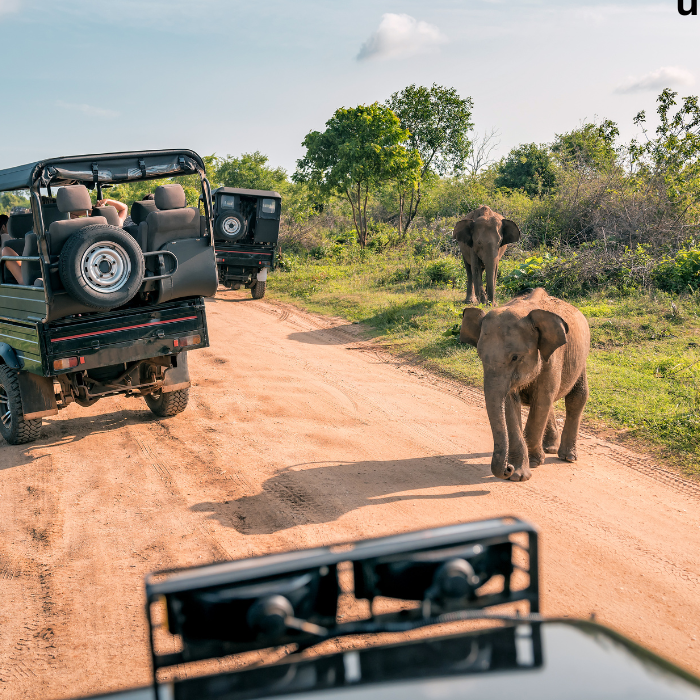

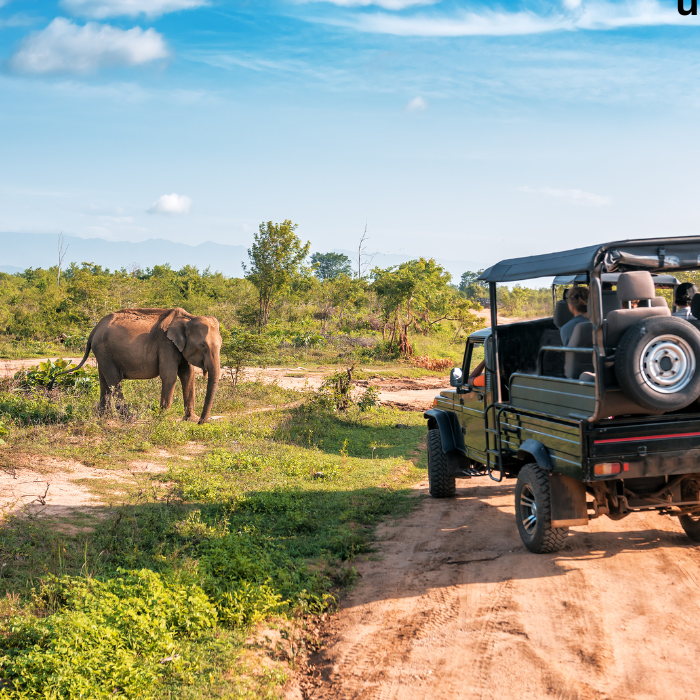

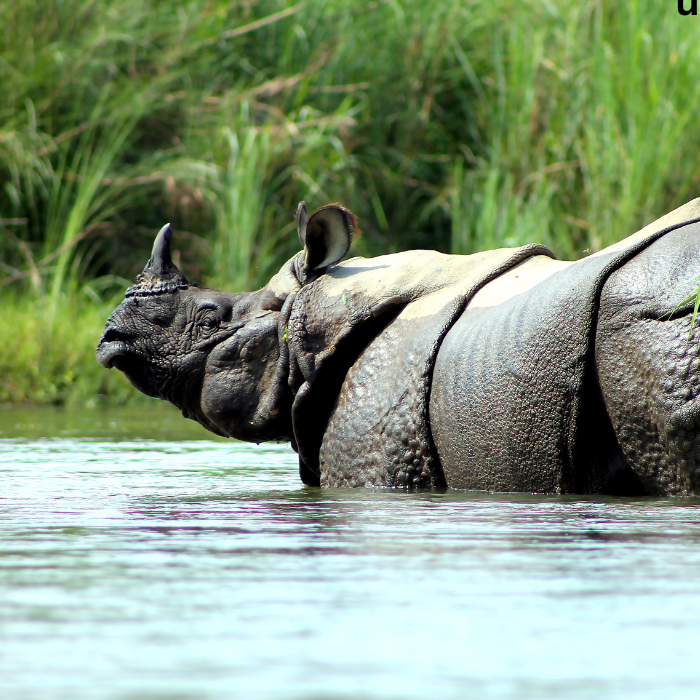


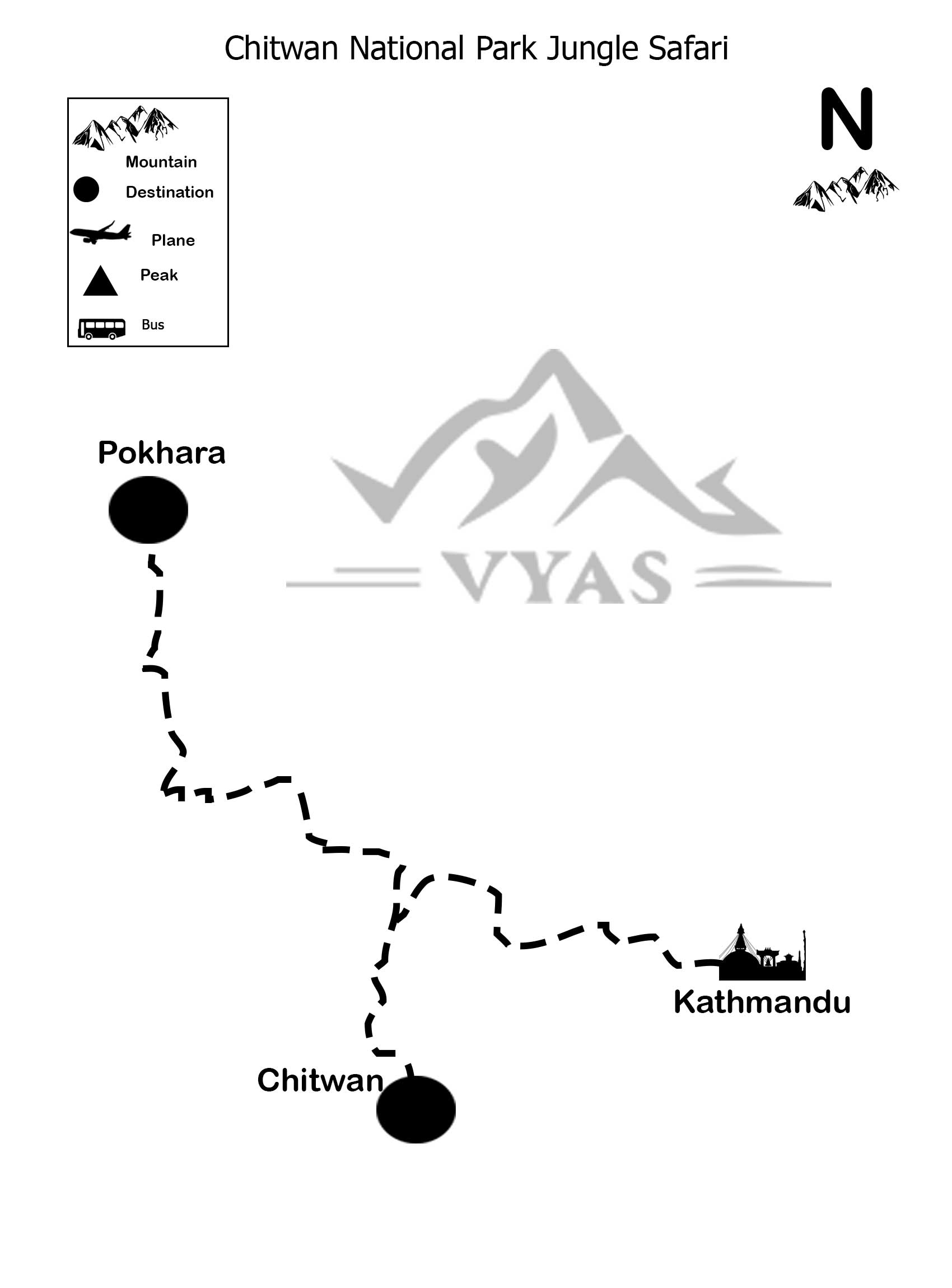


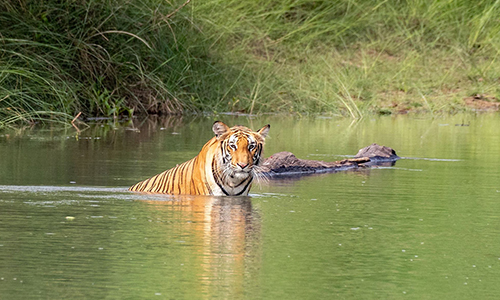

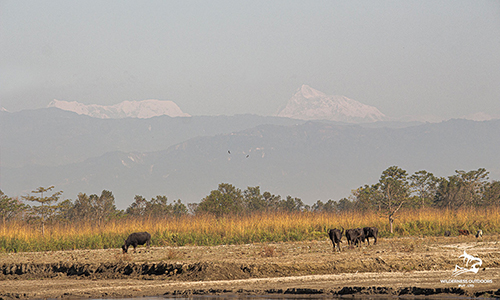


Anna Peterson
2025-06-16 12:21:17
The Chitwan National Park Jungle Safari with Vyas Treks Nepal was an amazing experience! We saw rhinos, deer, elephants, and even a tiger from a safe distance. The guides were very knowledgeable and shared fascinating facts about the wildlife and ecosystem. The jeep and canoe rides added variety and excitement to the trip. The entire team was friendly and made sure we were comfortable and safe throughout. Highly recommended for wildlife enthusiasts!